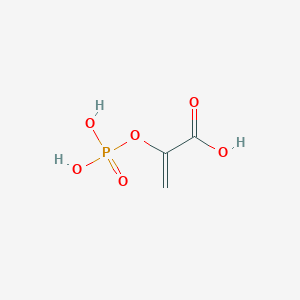Details of Metabolite
| Full List of Protein(s) Regulating This Metabolite | ||||||
|---|---|---|---|---|---|---|
| GPCR rhodopsin (GPCR-1) | ||||||
| Adrenergic receptor beta-3 (ADRB3) | Click to Show/Hide the Full List of Regulating Pair(s): 1 Pair(s) | |||||
| Detailed Information |
Protein Info
 click to show the details of this protein click to show the details of this protein
|
|||||
| Regulating Pair |
Experim Info
 click to show the details of experiment for validating this pair click to show the details of experiment for validating this pair
|
[1] | ||||
| Introduced Variation | Agonist (CL-316,243) of Adrb3 | |||||
| Induced Change | Phosphoenolpyruvate concentration: increase | |||||
| Summary | Introduced Variation
|
|||||
| Disease Status | Healthy individual | |||||
| Details | It is reported that agonist of ADRB3 leads to the increase of phosphoenolpyruvate levels compared with control group. | |||||
| GPCR secretin (GPCR-2) | ||||||
| Glucagon receptor (GCGR) | Click to Show/Hide the Full List of Regulating Pair(s): 1 Pair(s) | |||||
| Detailed Information |
Protein Info
 click to show the details of this protein click to show the details of this protein
|
|||||
| Regulating Pair |
Experim Info
 click to show the details of experiment for validating this pair click to show the details of experiment for validating this pair
|
[2] | ||||
| Introduced Variation | Knockout of Gcgr | |||||
| Induced Change | Phosphoenolpyruvate concentration: decrease (FC = 2.3) | |||||
| Summary | Introduced Variation
|
|||||
| Disease Status | Type 2 diabetes mellitus [ICD-11: 5A11] | |||||
| Details | It is reported that knockout of GCGR leads to the decrease of phosphoenolpyruvate levels compared with control group. | |||||
| Oxidoreductases (EC 1) | ||||||
| Alcohol dehydrogenase iron 1 (ADHFE1) | Click to Show/Hide the Full List of Regulating Pair(s): 1 Pair(s) | |||||
| Detailed Information |
Protein Info
 click to show the details of this protein click to show the details of this protein
|
|||||
| Regulating Pair |
Experim Info
 click to show the details of experiment for validating this pair click to show the details of experiment for validating this pair
|
[3] | ||||
| Introduced Variation | Overexpression of ADHFE1 | |||||
| Induced Change | Phosphoenolpyruvate concentration: increase | |||||
| Summary | Introduced Variation
|
|||||
| Disease Status | Breast cancer [ICD-11: 2C60] | |||||
| Details | It is reported that overexpression of ADHFE1 leads to the increase of phosphoenolpyruvate levels compared with control group. | |||||
| Transcription factor (TF) | ||||||
| Forkhead box protein O1 (FOXO1) | Click to Show/Hide the Full List of Regulating Pair(s): 1 Pair(s) | |||||
| Detailed Information |
Protein Info
 click to show the details of this protein click to show the details of this protein
|
|||||
| Regulating Pair |
Experim Info
 click to show the details of experiment for validating this pair click to show the details of experiment for validating this pair
|
[4] | ||||
| Introduced Variation | Overexpression of Foxo1 | |||||
| Induced Change | Phosphoenolpyruvate concentration: increase (FC = 1.70) | |||||
| Summary | Introduced Variation
|
|||||
| Disease Status | Healthy individual | |||||
| Details | It is reported that overexpression of Foxo1 leads to the increase of phosphoenolpyruvate levels compared with control group. | |||||
| Myc proto-oncogene protein (MYC) | Click to Show/Hide the Full List of Regulating Pair(s): 1 Pair(s) | |||||
| Detailed Information |
Protein Info
 click to show the details of this protein click to show the details of this protein
|
|||||
| Regulating Pair |
Experim Info
 click to show the details of experiment for validating this pair click to show the details of experiment for validating this pair
|
[5] | ||||
| Introduced Variation | Knockdown (siRNA) of MYC | |||||
| Induced Change | Phosphoenolpyruvate concentration: decrease | |||||
| Summary | Introduced Variation
|
|||||
| Disease Status | Colorectal cancer [ICD-11: 2B91] | |||||
| Details | It is reported that knockdown of MYC leads to the decrease of phosphoenolpyruvate levels compared with control group. | |||||
If you find any error in data or bug in web service, please kindly report it to Dr. Zhang and Dr. Mou.

